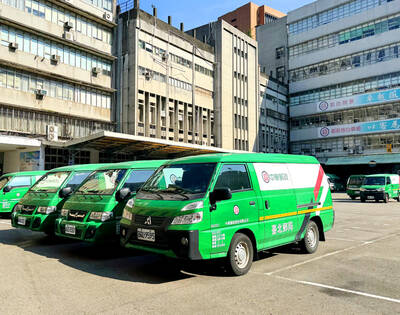The Chinese military is engaging in “gunboat diplomacy” by holding unannounced live-fire drills near Taiwan, Australia and New Zealand, and is demonstrating its intent to counterbalance the US, academics said.
The Chinese People’s Liberation Army (PLA) on Wednesday set up a zone for “shooting” drills about 40 nautical miles (74km) off the coasts of Kaohsiung and Pingtung County without giving Taiwan prior notice, the Ministry of National Defense said that day.
The PLA on Feb. 21 and Feb. 22 conducted a live-fire exercise in the Tasman Sea between Australia and New Zealand, also without notifying the authorities in advance.

Photo: AFP
Live rounds were fired in the drills near New Zealand, but were not in the drills near Taiwan. However, in both areas civilian aircraft had to modify their flight paths, including some in mid-flight, after receiving reports of the live-fire exercises.
Lin Ying-yu (林穎佑), an assistant professor at Tamkang University’s Graduate Institute of International Affairs and Strategic Studies, said that such moves could be seen as a response to recent military and diplomatic developments related to the US.
These include a joint US-Japan-France naval drill in the Philippine Sea, the US Department of State dropping wording on its Web site saying it does not support Taiwanese independence and the release of previously frozen US foreign aid with US$870 million in security exemptions for programs in Taiwan, Lin said.
The PLA drills in international waters without prior notice were a form of “gunboat diplomacy,” Lin said, adding that Beijing is using military actions to send political signals to those countries and beyond.
He said that whether the PLA announces a drill in advance depends on its size and political purpose, with Beijing more likely to publicize larger exercises.
Lin cited two examples of larg drills that were announced beforehand — the “Joint Sword-2024” exercises and the military encirclement of Taiwan following then-US House of Representatives speaker Nancy Pelosi’s visit in 2022.
Having Chinese warships carry out exercises off Taiwan’s southern coast and near Australia and New Zealand also signaled China’s intent to show its ability to block US military intervention in Taiwan-related affairs from the western and southern Pacific, he said.
The maneuvers could also be seen as a reaction to the US military’s longstanding policy of freedom of navigation operations to assert and protect the right of free passage wherever international law allows, he said.
The Chinese military wanted to show that its warships could also assert their rights to free passage in international waters, as well as back up the claim that “China is now capable of keeping up with the US,” Lin said.
Su Tzu-yun (蘇紫雲), director of the Division of Defense Strategy and Resources at the military-funded Institute for National Defense and Security Research, said the Chinese military is increasingly engaging in “gunboat diplomacy” as its fleet expands and matures.
Historically, when regional tensions arose, US aircraft carriers would typically move into the area as a response, which the Chinese military appears to be mimicking, Su said.
Regarding the timing of the Chinese military exercises off Taiwan’s southern coast, Su said it could be linked to the recent deepening of military cooperation between Taiwan and the US.
In the short term, China wants to project military power and intimidate Taiwan by conducting drills at specific times, while over the long-term it is attempting to shift from being a land-based power to a maritime power, Su said.
There are no binding international regulations requiring prior notification of such exercises to other countries, Su said, adding that similar unannounced drills by the Chinese military in international waters might grow more frequent.
However, such actions are highly irresponsible and potentially pose a threat to maritime navigation, he said.

SHIPS, TRAINS AND AUTOMOBILES: The ministry has announced changes to varied transportation industries taking effect soon, with a number of effects for passengers Beginning next month, the post office is canceling signature upon delivery and written inquiry services for international registered small packets in accordance with the new policy of the Universal Postal Union, the Ministry of Transportation and Communications said yesterday. The new policy does not apply to packets that are to be delivered to China, the ministry said. Senders of international registered small packets would receive a NT$10 rebate on postage if the packets are sent from Jan. 1 to March 31, it added. The ministry said that three other policies are also scheduled to take effect next month. International cruise ship operators

NUMBERS IMBALANCE: More than 4 million Taiwanese have visited China this year, while only about half a million Chinese have visited here Beijing has yet to respond to Taiwan’s requests for negotiation over matters related to the recovery of cross-strait tourism, the Tourism Administration said yesterday. Taiwan’s tourism authority issued the statement after Chinese-language daily the China Times reported yesterday that the government’s policy of banning group tours to China does not stop Taiwanese from visiting the country. As of October, more than 4.2 million had traveled to China this year, exceeding last year. Beijing estimated the number of Taiwanese tourists in China could reach 4.5 million this year. By contrast, only 500,000 Chinese tourists are expected in Taiwan, the report said. The report

The Forestry and Nature Conservation Agency yesterday launched a gift box to market honey “certified by a Formosan black bear” in appreciation of a beekeeper’s amicable interaction with a honey-thieving bear. Beekeeper Chih Ming-chen (池明鎮) in January inspected his bee farm in Hualien County’s Jhuosi Township (卓溪) and found that more than 20 beehives had been destroyed and many hives were eaten, with bear droppings and paw prints near the destroyed hives, the agency said. Chih returned to the farm to move the remaining beehives away that evening when he encountered a Formosan black bear only 20m away, the agency said. The bear

HORROR STORIES: One victim recounted not realizing they had been stabbed and seeing people bleeding, while another recalled breaking down in tears after fleeing A man on Friday died after he tried to fight the knife-wielding suspect who went on a stabbing spree near two of Taipei’s busiest metro stations, Taipei Mayor Chiang Wan-an (蔣萬安) said. The 57-year-old man, identified by his family name, Yu (余), encountered the suspect at Exit M7 of Taipei Main Station and immediately tried to stop him, but was fatally wounded and later died, Chiang said, calling the incident “heartbreaking.” Yu’s family would receive at least NT$5 million (US$158,584) in compensation through the Taipei Rapid Transit Corp’s (TRTC) insurance coverage, he said after convening an emergency security response meeting yesterday morning. National